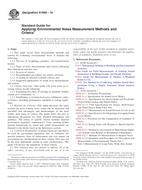Potrebujeme váš súhlas na využitie jednotlivých dát, aby sa vám okrem iného mohli ukazovať informácie týkajúce sa vašich záujmov. Súhlas udelíte kliknutím na tlačidlo „OK“.
ASTM E1686-10
Standard Guide for Applying Environmental Noise Measurement Methods and Criteria
Automaticky preložený názov:
Štandardné príručka pre Použitie hluku vo vonkajšom prostredí metódy a kritériá merania
NORMA vydaná dňa 1.9.2010
Informácie o norme:
Označenie normy: ASTM E1686-10
Poznámka: NEPLATNÁ
Dátum vydania normy: 1.9.2010
Kód tovaru: NS-42649
Počet strán: 12
Približná hmotnosť: 36 g (0.08 libier)
Krajina: Americká technická norma
Kategória: Technické normy ASTM
Anotácia textu normy ASTM E1686-10 :
Keywords:
community noise, environmental noise, noise, noise assessment, noise criteria, noise evaluation, noise level measurement, noise metrics, A-weighted sound level, Community noise equivalent level (CNEL), C-weighted sound level, Day-night average sound level (Leq), Environmental noise measurements, Frequency-weighted sound level, Impulse sound measurement, Noise level measurement, Noise metrics, Noise pollution level (PNL), Sound exposure level (SEL), Sound transmission
Doplňujúce informácie
| Significance and Use | ||||||||
|
Evaluation of Environmental Noise—Environmental noise is evaluated by comparing a measurement or prediction of the noise to one or more criteria. There are many different criteria and ways of measuring and specifying noise, depending on the purpose of the evaluation. Selection of Criteria—This guide assists in selecting the appropriate criteria and measurement method to evaluate noise. In making the selection, the user should consider the following: purpose of the evaluation (compatibility, activity interference, aesthetics, comfort, annoyance, health effects, hearing damage, etc.); type of data that are available or could be available (A-weighted, octave-band, average level, maximum level, day-night level, calibrated recordings including .wav files from which various measurements could be made, etc.); available budget for instrumentation and manpower to obtain that data; and regulatory or legal requirements for the use of a specific criterion. After selecting a measurement method, the user should consult appropriate references for more detailed guidance. 4.3 Objective versus Subjective Evaluations—The overall sound environment as perceived outdoors is often called a soundscape. Soundscapes have both objective (quantitative) and subjective (qualitative) attributes. This guide is limited to the objective measurement and evaluation of sound found outdoors though the criteria used may be influenced by qualitative factors. Current soundscape research involves evaluation methods and criteria that rely extensively on qualitative factors, both acoustical and non-acoustical, while including requirements for quantitative sound measurement. Two basic tenets of quantitative soundscape measurements are that the ambient sound at a location is comprised of a combination of specific acoustic events that can be measured individually and in combinations; and that the sounds should be measured using methods that represent the ways in which they are heard by people. (1) |
||||||||
| 1. Scope | ||||||||
|
1.1 This guide covers many measurement methods and criteria for evaluating environmental noise. It includes the following: 1.1.1 The use of weightings, penalties, and normalization factors; 1.1.2 Types of noise measurements and criteria, indicating their limitations and best uses; 1.1.3 Sources of criteria; 1.1.4 Recommended procedures for criteria selection; 1.1.5 A catalog of selected available criteria; and 1.1.6 Suggested applications of sound level measurements and criteria. 1.2 Criteria Selection—This guide will assist users in selecting criteria for the following: 1.2.1 Evaluating the effect of existing or potential outdoor sounds on a community; or 1.2.2 Establishing or revising local noise ordinances, codes, or bylaws, including performance standards in zoning regulations. 1.3 Reasons for Criteria—This guide discusses the many reasons for noise criteria, ways sound can be measured and specified, and advantages and disadvantages of the most widely used types of criteria. The guide refers the user to appropriate documents for more detailed information and guidance. The listing of specific criteria includes national government regulatory requirements. Users needing further general background on sound and sound measurement are directed to the books listed in the References section. 1.4 Criteria in Regulations—Certain criteria are specified to be used by government regulation, law, or ordinance for specific purposes. Ease of enforcement and cost impact on government are considerations for these criteria. They may not be the most appropriate criteria in some circumstances. This guide will discuss the limitations of these criteria. 1.5 This standard does not purport to address all of the safety concerns, if any, associated with its use. It is the responsibility of the user of this standard to establish appropriate safety and health practices and determine the applicability of regulatory limitations prior to use. |
||||||||
| 2. Referenced Documents | ||||||||
|



 Cookies
Cookies
